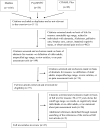Self-report pain assessment tools for cognitively intact older adults: Integrative review
- PMID: 28980440
- PMCID: PMC5886828
- DOI: 10.1111/opn.12170
Self-report pain assessment tools for cognitively intact older adults: Integrative review
Abstract
Background: Pain is common in older adults, but it is often underreported or undertreated partly because many consider pain to be a normal consequence of ageing. Among the plethora of available self-report pain assessment tools, there is no synthetised evidence which tools are indicated for use among cognitively intact older adults.
Purpose of the study: To understand documented self-report pain assessment tools that have been used among cognitively intact older adults, and to describe their characteristics including overall performance as well as studies demonstrating their use.
Methods: A systematic search of the indexed databases PubMed, PsycINFO and Cumulative Index to Nursing and Allied Health Literature (CINAHL Plus) was conducted to identify documented self-report pain assessment tools through peer-reviewed papers, including citations from January 1990 to December 2015. Thirty-five percentage of abstracts were independently evaluated by two raters according to specific criteria.
Results: Among identified tools, the Iowa Pain Thermometer, the 6-point Verbal Descriptor Scale, the Numeric Rating Scale, the short form Brief Pain Inventory (BPI) and the Geriatric Pain Measure (GPM) may be suitable tools for self-reported pain by cognitively intact older adults based on the statement of the literature. Only two self-report tools (the GPM and the Geriatric Painful Events Inventory) were designed specifically for older adults.
Conclusions: More studies are needed to evaluate pain measures' psychometric performance across different settings, racial/ethnic groups and disease categories. Since 80% of older adults have at least one chronic disease, multidimensional tools such as the GPM may need to be used more often for accurate self-report of pain.
Implications for practice: Examining the psychometric properties of comprehensive self-report pain assessment tools informs recommendations for the selection of tools to be used in clinical practice.
Keywords: ageing; gerontology; older people; pain assessment.
© 2017 John Wiley & Sons Ltd.
Similar articles
-
The self-administered 24-item geriatric pain measure (GPM-24-SA): psychometric properties in three European populations of community-dwelling older adults.Pain Med. 2008 Sep;9(6):695-709. doi: 10.1111/j.1526-4637.2008.00497.x. Pain Med. 2008. PMID: 18816330 Clinical Trial.
-
The application of facial expressions to the assessment of orofacial pain in cognitively impaired older adults.J Am Dent Assoc. 2007 Jul;138(7):963-9; quiz 1021-2. doi: 10.14219/jada.archive.2007.0293. J Am Dent Assoc. 2007. PMID: 17606495
-
Development of a pain assessment tool for the older adults in Korea: the validity and reliability of a Korean version of the geriatric pain measure (GPM-K).Arch Gerontol Geriatr. 2009 Sep-Oct;49(2):199-203. doi: 10.1016/j.archger.2008.07.010. Epub 2008 Sep 10. Arch Gerontol Geriatr. 2009. PMID: 18786737
-
The state-of-"cultural validity" of self-report pain assessment tools in diverse older adults.Pain Med. 2015 Feb;16(2):232-9. doi: 10.1111/pme.12496. Epub 2014 Sep 15. Pain Med. 2015. PMID: 25219949 Review.
-
Paramedic assessment of pain in the cognitively impaired adult patient.BMC Emerg Med. 2009 Oct 6;9:20. doi: 10.1186/1471-227X-9-20. BMC Emerg Med. 2009. PMID: 19807928 Free PMC article. Review.
Cited by
-
Association between Chronic Pain and Sarcopenia in Greek Community-Dwelling Older Adults: A Cross-Sectional Study.Healthcare (Basel). 2024 Jun 29;12(13):1303. doi: 10.3390/healthcare12131303. Healthcare (Basel). 2024. PMID: 38998838 Free PMC article.
-
Predicting and evaluating pain after surgery…Newer methods to the rescue?Indian J Anaesth. 2023 Feb;67(Suppl 2):S77-S80. doi: 10.4103/ija.ija_65_23. Epub 2023 Feb 22. Indian J Anaesth. 2023. PMID: 37122932 Free PMC article. No abstract available.
-
Combining Electrodermal Activity With the Peak-Pain Time to Quantify Three Temporal Regions of Pain Experience.Front Pain Res (Lausanne). 2022 Mar 23;3:764128. doi: 10.3389/fpain.2022.764128. eCollection 2022. Front Pain Res (Lausanne). 2022. PMID: 35399152 Free PMC article.
-
Pain in the Context of Virtual Neuropsychological Assessment of Older Adults.Arch Clin Neuropsychol. 2024 Feb 19;39(2):157-166. doi: 10.1093/arclin/acad064. Arch Clin Neuropsychol. 2024. PMID: 37644879 Free PMC article.
-
Prevalence and persistent use of analgesic drugs in older adults receiving domiciliary care at baseline-A longitudinal study.Health Sci Rep. 2021 Jul 1;4(3):e316. doi: 10.1002/hsr2.316. eCollection 2021 Sep. Health Sci Rep. 2021. PMID: 34250268 Free PMC article.
References
-
- American Geriatric Society. The management of persistent pain in older persons. Journal of the American Geriatrics Society. 2002;50(6 Suppl):s205–s224. - PubMed
-
- Benesh LR, Szigeti E, Ferraro FR, Gullicks JN. Tools for assessing chronic pain in rural elderly women. Home Healthcare Nurse. 1997;15(3):207–211. - PubMed
-
- Bergh I, Sjostrom B, Oden A, Steen B. An application of pain rating scales in geriatric patients. Aging (Milan, Italy) 2000;12(5):380–387. - PubMed
-
- Bergh I, Sjostrom B, Oden A, Steen B. Assessing pain and pain relief in geriatric patients with non-pathological fractures with different rating scales. Aging (Milan, Italy) 2001;13(5):355–361. - PubMed
Publication types
MeSH terms
Grants and funding
LinkOut - more resources
Full Text Sources
Other Literature Sources
Research Materials


